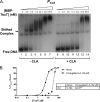Conjugated Linoleic Acid Reduces Cholera Toxin Production In Vitro and In Vivo by Inhibiting Vibrio cholerae ToxT Activity
- PMID: 26392502
- PMCID: PMC4649248
- DOI: 10.1128/AAC.01029-15
Conjugated Linoleic Acid Reduces Cholera Toxin Production In Vitro and In Vivo by Inhibiting Vibrio cholerae ToxT Activity
Erratum in
-
Erratum for Withey et al., "Conjugated Linoleic Acid Reduces Cholera Toxin Production In Vitro and In Vivo by Inhibiting Vibrio cholerae ToxT Activity".Antimicrob Agents Chemother. 2019 Jan 29;63(2):e02493-18. doi: 10.1128/AAC.02493-18. Print 2019 Feb. Antimicrob Agents Chemother. 2019. PMID: 30696692 Free PMC article. No abstract available.
Abstract
The severe diarrheal disease cholera is endemic in over 50 countries. Current therapies for cholera patients involve oral and/or intravenous rehydration, often combined with the use of antibiotics to shorten the duration and intensity of the disease. However, as antibiotic resistance increases, treatment options will become limited. Linoleic acid has been shown to be a potent negative effector of V. cholerae virulence that acts on the major virulence transcription regulator protein, ToxT, to inhibit virulence gene expression. ToxT activates transcription of the two major virulence factors required for disease, cholera toxin (CT) and toxin-coregulated pilus (TCP). A conjugated form of linoleic acid (CLA) is currently sold over the counter as a dietary supplement and is generally recognized as safe by the U.S. Food and Drug Administration. This study examined whether CLA could be used as a new therapy to reduce CT production, which, in turn, would decrease disease duration and intensity in cholera patients. CLA could be used in place of traditional antibiotics and would be very unlikely to generate resistance, as it affects only virulence factor production and not bacterial growth or survival.
Copyright © 2015, American Society for Microbiology. All Rights Reserved.
Figures





Similar articles
-
Sodium butyrate inhibits the expression of virulence factors in Vibrio cholerae by targeting ToxT protein.mSphere. 2025 May 27;10(5):e0082424. doi: 10.1128/msphere.00824-24. Epub 2025 Apr 22. mSphere. 2025. PMID: 40261078 Free PMC article.
-
Mechanism for inhibition of Vibrio cholerae ToxT activity by the unsaturated fatty acid components of bile.J Bacteriol. 2015 May;197(10):1716-25. doi: 10.1128/JB.02409-14. Epub 2015 Mar 2. J Bacteriol. 2015. PMID: 25733618 Free PMC article.
-
H-NS and ToxT Inversely Control Cholera Toxin Production by Binding to Overlapping DNA Sequences.J Bacteriol. 2021 Aug 20;203(18):e0018721. doi: 10.1128/JB.00187-21. Epub 2021 Aug 20. J Bacteriol. 2021. PMID: 34228499 Free PMC article.
-
Regulation of virulence in Vibrio cholerae.Int J Med Microbiol. 2001 May;291(2):81-8. doi: 10.1078/1438-4221-00104. Int J Med Microbiol. 2001. PMID: 11437342 Review.
-
Regulation of virulence in Vibrio cholerae: the ToxR regulon.Future Microbiol. 2007 Jun;2(3):335-44. doi: 10.2217/17460913.2.3.335. Future Microbiol. 2007. PMID: 17661707 Review.
Cited by
-
Fatty acid synthesis promoted by PA1895-1897 operon delays quorum sensing activation in Pseudomonas aeruginosa.AMB Express. 2024 Oct 1;14(1):110. doi: 10.1186/s13568-024-01758-5. AMB Express. 2024. PMID: 39354164 Free PMC article.
-
Free Fatty Acids Interfere with the DNA Binding Activity of the Virulence Regulator PrfA of Listeria monocytogenes.J Bacteriol. 2020 Jul 9;202(15):e00156-20. doi: 10.1128/JB.00156-20. Print 2020 Jul 9. J Bacteriol. 2020. PMID: 32393522 Free PMC article.
-
Sodium butyrate inhibits the expression of virulence factors in Vibrio cholerae by targeting ToxT protein.mSphere. 2025 May 27;10(5):e0082424. doi: 10.1128/msphere.00824-24. Epub 2025 Apr 22. mSphere. 2025. PMID: 40261078 Free PMC article.
-
Long Chain Fatty Acids and Virulence Repression in Intestinal Bacterial Pathogens.Front Cell Infect Microbiol. 2022 Jun 17;12:928503. doi: 10.3389/fcimb.2022.928503. eCollection 2022. Front Cell Infect Microbiol. 2022. PMID: 35782143 Free PMC article. Review.
-
Anti-infective activities of long-chain fatty acids against foodborne pathogens.FEMS Microbiol Rev. 2023 Jul 5;47(4):fuad037. doi: 10.1093/femsre/fuad037. FEMS Microbiol Rev. 2023. PMID: 37437907 Free PMC article. Review.
References
-
- World Health Organization. 2013. Cholera, 2012. Wkly Epidemiol Rec 88:321–334. - PubMed
-
- WHO. 2006. Oral rehydration salts: production of the new ORS. WHO, Geneva, Switzerland.
Publication types
MeSH terms
Substances
LinkOut - more resources
Full Text Sources
Medical

